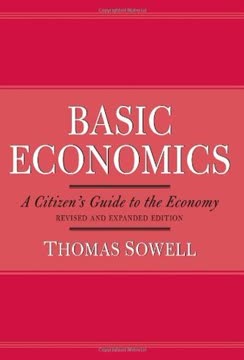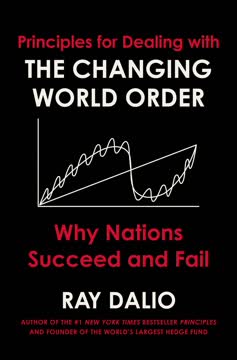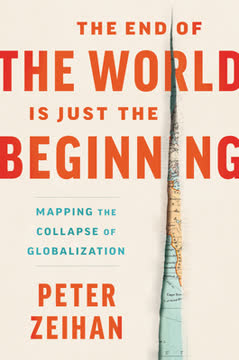Key Takeaways
1. America's Rise: From Colonial Backwater to Global Superpower
"Imagine that a version of the World Economic Forum was held in Davos in 1620. The great and the good from across the world are assembled in the Alpine village: Chinese scholars in their silk robes, British adventurers in their doublets and jerkins, Turkish civil servants in their turbans and caftans . . . all edge along the icy paths, frequently tumbling over, or gather in the inns and restaurants, animated by alcohol."
From Humble Beginnings: In 1620, North America was an empty space on the map, with no economic significance. Yet by the early 20th century, the United States had become the world's largest economy, producing a quarter of global GDP with just 5% of the world's population.
Factors for Success:
- Vast natural resources and land
- Liberal political institutions and property rights
- Entrepreneurial culture and openness to immigration
- Technological innovation and industrial prowess
The United States leveraged these advantages to become a leader in industries ranging from agriculture to manufacturing, developing a diverse and resilient economy. This economic might translated into global influence, with America playing a decisive role in both World Wars and emerging as a superpower in the 20th century.
2. The Civil War: A Turning Point for American Capitalism
"The Civil War eventually decided which version of America would emerge—and the United States tirelessly spread its version of a business civilization across the entire continent."
Economic Divide: The Civil War represented a clash between two economic systems: the industrial, free-labor North and the agrarian, slave-based South. This conflict would determine the future course of American capitalism.
Consequences of Northern Victory:
- Abolition of slavery, freeing a significant portion of the labor force
- Acceleration of industrialization and westward expansion
- Centralization of economic power in the federal government
- Creation of a national currency and banking system
The war's outcome set the stage for America's rapid economic growth in the late 19th century, as the country embraced industrialization, free labor, and a more integrated national market. However, it also left lasting economic disparities between North and South that would persist for generations.
3. The Gilded Age: Titans of Industry and Economic Transformation
"The second half of the nineteenth century saw a revolution in the scale of economic life."
Rise of Big Business: The post-Civil War era saw the emergence of industrial giants in sectors like oil, steel, and railroads. Entrepreneurs like John D. Rockefeller, Andrew Carnegie, and J.P. Morgan built vast business empires through innovation, integration, and often ruthless competition.
Key Developments:
- Rapid technological innovation (e.g., electricity, telephones)
- Expansion of railroads, creating a national market
- Rise of the modern corporation and financial markets
- Unprecedented wealth concentration alongside widespread poverty
This period of rapid economic growth and industrialization transformed America into the world's leading economic power. However, it also generated significant social and economic tensions, including labor unrest, political corruption, and growing inequality.
4. Progressive Era: Taming Unfettered Capitalism
"The Progressive intellectuals inhabited a different world from the rural radicals or trade union activists: they were middle-class professionals who made comfortable livings as professors, journalists, lawyers, and government officials and who instinctively looked down on the worker, particularly those born abroad, wondering whether they should be allowed to vote, or even to have children."
Reform Movement: The excesses of the Gilded Age sparked a diverse reform movement aimed at addressing the social and economic problems of industrial capitalism.
Key Progressive Reforms:
- Antitrust legislation to break up monopolies
- Labor laws (e.g., child labor restrictions, workplace safety)
- Food and drug regulation
- Conservation of natural resources
- Expansion of democratic participation (e.g., direct election of senators)
The Progressive Era saw a significant expansion of government's role in regulating the economy and addressing social issues. This laid the groundwork for many 20th-century reforms and established a new balance between free-market capitalism and government intervention.
5. Roaring Twenties: Prosperity, Innovation, and the Seeds of Crisis
"The 1920s was arguably the last decade when the size of government could be restrained, and the United States the last rich country where that arduous feat could be performed."
Economic Boom: The 1920s saw rapid economic growth, technological innovation, and rising living standards for many Americans. This was driven by factors such as mass production techniques, the spread of consumer goods (especially automobiles), and a pro-business political climate.
Key Features of the 1920s Economy:
- Surge in consumer goods and credit
- Rapid adoption of new technologies (e.g., radio, electricity)
- Bull market in stocks
- Relatively low government intervention in the economy
However, the decade's prosperity masked underlying weaknesses:
- Growing income inequality
- Overproduction in some sectors
- Speculative bubble in the stock market
- Weak international economic system
These factors would contribute to the devastating economic crash that followed, highlighting the risks of unregulated capitalism and setting the stage for a new era of government intervention.
6. The Great Depression: Economic Collapse and New Deal Response
"The Depression was deeper than anything comparable countries had experienced: at its height, about a quarter of the workforce was unemployed. It was also longer: the Depression ground on for more than twelve long years and the economy did not really return to its full productive capacity until the buildup of the World War II years (1941–45)."
Economic Catastrophe: The Great Depression was an unprecedented economic collapse that devastated the United States and much of the world in the 1930s. It exposed the vulnerabilities of the American economic system and shattered faith in unfettered capitalism.
Key Features of the Depression:
- Mass unemployment (peaking at 25%)
- Banking crisis and credit contraction
- Collapse in industrial production and trade
- Deflation and widespread poverty
New Deal Response: President Franklin D. Roosevelt's New Deal represented a dramatic expansion of government's role in the economy:
- Banking and financial reforms
- Public works programs and job creation
- Social welfare programs (e.g., Social Security)
- Labor rights and unionization support
- Agricultural price supports
The New Deal fundamentally altered the relationship between government, business, and citizens in the United States, establishing many of the key features of the modern American welfare state and mixed economy.
7. Post-War Boom: America's Golden Age of Growth
"The United States emerged from the Second World War a giant among midgets. A country with 7 percent of the world's population produced 42 percent of its manufactured goods, 43 percent of its electricity, 57 percent of its steel, 62 percent of its oil, and 80 percent of its cars."
Economic Dominance: The post-World War II era saw unprecedented prosperity and growth in the United States, with rising living standards, technological innovation, and global economic leadership.
Key Features of the Post-War Boom:
- Rapid GDP and productivity growth
- Rising middle-class incomes and consumption
- Expansion of higher education and skilled workforce
- Dominance in key industries (e.g., automobiles, electronics)
- Global economic leadership (Bretton Woods system, Marshall Plan)
This period, often called the "Golden Age of Capitalism," saw a unique combination of factors that supported sustained growth:
- Pent-up consumer demand and savings from the war years
- Technological innovations from wartime research
- Stable international economic system under U.S. leadership
- Strong labor unions and rising wages
- Government policies supporting growth and full employment
However, by the late 1960s and early 1970s, cracks began to appear in this system, setting the stage for the economic challenges of the following decades.
8. Stagflation and Decline: The Crisis of the 1970s
"The 1970s was a dismal decade for the United States: the age of gold had turned into an age of lead, and many people were asking whether the American era was over."
Economic Turmoil: The 1970s saw a combination of economic problems that challenged the post-war economic model and American global leadership:
- Stagflation (high inflation and unemployment simultaneously)
- Oil price shocks
- Declining productivity growth
- Increased global competition, especially from Japan and Germany
Signs of Decline:
- End of the Bretton Woods monetary system
- Deindustrialization and the emergence of the "Rust Belt"
- Rising trade deficits
- Fiscal pressures from growing entitlement spending
This period of economic malaise coincided with other challenges (e.g., Vietnam War, Watergate) that contributed to a broader crisis of confidence in American institutions and leadership. It set the stage for a significant shift in economic policy and thinking in the following decade.
9. Reagan Revolution: Deregulation and the Resurgence of Free-Market Ideology
"Reagan has three undeniable economic achievements to his name. First, he broke the power of the unions."
Policy Shift: The Reagan administration marked a decisive turn away from the post-war consensus towards a more free-market oriented approach to economic policy.
Key Elements of Reaganomics:
- Tax cuts, especially on high incomes
- Deregulation of various industries
- Monetary policy focused on combating inflation
- Reduction in government spending (except defense)
- Weakening of labor unions
Outcomes:
- Reduction in inflation
- Economic recovery and growth
- Rising inequality
- Shift in the balance of power between labor and capital
- Increased financialization of the economy
The Reagan era represented a significant ideological shift in American economic thinking, emphasizing the virtues of free markets and entrepreneurship over government intervention. This approach would continue to influence economic policy debates in the following decades, even as its limitations became apparent.
Last updated:
FAQ
What's Capitalism in America about?
- Comprehensive History: Capitalism in America provides a detailed history of American capitalism from the 18th century to the present, illustrating its evolution into the world's largest economy.
- Key Themes: The book explores themes like productivity, creative destruction, and the interplay between politics and economics, showing how these factors have shaped the U.S. economic landscape.
- Lessons from History: It aims to draw lessons from the past to address contemporary economic challenges, questioning the U.S.'s ability to maintain its economic preeminence.
Why should I read Capitalism in America?
- Insightful Analysis: The book offers a deep dive into the forces driving American economic growth, essential for understanding capitalism's complexities.
- Authoritative Voices: Written by Alan Greenspan and Adrian Wooldridge, it combines expert analysis with engaging storytelling from respected figures in economics and journalism.
- Relevance to Current Issues: It addresses current economic concerns like stagnation and global competition, making it relevant for understanding today's economic climate.
What are the key takeaways of Capitalism in America?
- Rise of Capitalism: The book emphasizes America's unique historical context, fostering a dynamic capitalist economy.
- Creative Destruction: It highlights the concept where old industries are replaced by new ones, driving innovation and growth.
- Political and Economic Interplay: The authors discuss how political decisions and economic realities have historically influenced each other, shaping American capitalism.
What are the best quotes from Capitalism in America and what do they mean?
- Global Impact: "America has not only provided its own citizens with a prosperous life. It has exported prosperity in the form of innovations and ideas." This underscores America's role as a leader in innovation.
- Essence of Capitalism: "The process of creative destruction is the essential fact about capitalism." This highlights that economic progress often involves dismantling old structures for new ones.
- Democracy and Governance: "The more you opened the way to the rule of the people, the more you had to make sure that the people didn’t abuse their power." This reflects the balance needed in a capitalist society.
How does Capitalism in America define capitalism?
- Economic System: Capitalism is defined as an economic system characterized by private ownership and profit pursuit, evolving uniquely in America.
- Democratic Capitalism: It emphasizes American capitalism as distinctively democratic, allowing social mobility and merit-based opportunities.
- Role of Innovation: Innovation is a driving force, with the U.S. leading in technological advancements reshaping industries and improving living standards.
What is the concept of creative destruction in Capitalism in America?
- Driving Force of Progress: Creative destruction is the process where new innovations replace outdated industries, leading to growth and productivity.
- Historical Examples: The book provides examples like the transition from horse-drawn carriages to automobiles, illustrating this constant in American history.
- Social Implications: While fostering growth, it also leads to job displacement, necessitating a balance between innovation and social safety nets.
How do the authors address the issue of inequality in Capitalism in America?
- Concentration of Wealth: The book discusses how large corporations and wealth concentration can lead to economic inequality, challenging equal opportunity ideals.
- Historical Context: It places inequality within a historical framework, showing how policies and practices have widened gaps between rich and poor.
- Call for Reform: The authors suggest thoughtful reforms to balance capitalism's benefits with the need for social equity.
What role does government play in Capitalism in America?
- Regulatory Framework: Government establishes the regulatory framework for capitalism, including protecting property rights and enforcing contracts.
- Intervention vs. Laissez-Faire: The book explores the tension between laissez-faire principles and government intervention, especially during crises.
- Historical Shifts: It highlights shifts in government policy, like the New Deal, shaping American capitalism's landscape.
How does Capitalism in America explain the rise of big business?
- Scale and Efficiency: The rise of big business was driven by the need for scale and efficiency, especially in capital-intensive industries.
- Innovative Management: Innovative management practices and corporate structures allowed rapid growth and market dominance.
- Economic Context: The rise is placed within the broader context of American economic expansion, including railroads and technological advancements.
What are the challenges facing American capitalism today, according to Capitalism in America?
- Stagnation and Competition: Challenges include stagnation in productivity growth and competition from countries like China.
- Regulatory Burdens: Increasing regulations and a complex tax system can stifle innovation and entrepreneurship.
- Social and Political Divisions: Growing divisions could undermine American capitalism's foundations, calling for reforms to restore dynamism and equity.
How does Capitalism in America suggest restoring America’s economic dynamism?
- Reforming Entitlements: The authors advocate for entitlement program reforms to ensure they don't crowd out investment and growth.
- Financial System Overhaul: They suggest financial system reforms to prevent crises and support economic activity.
- Encouraging Innovation: Emphasizing the importance of fostering an environment that encourages innovation and entrepreneurship.
How does Capitalism in America address globalization?
- Global Trade Agreements: The book discusses trade agreements like NAFTA and their effects on the U.S. economy, facilitating increased trade.
- Impact on Labor: It examines globalization's consequences on labor markets, including job displacement in certain sectors.
- America's Role: The U.S. is portrayed as a key player in promoting globalization, with responsibilities and challenges in a changing global economy.
Review Summary
Capitalism in America receives mixed reviews. Many praise its readability and comprehensive economic history, finding it informative and thought-provoking. Readers appreciate Greenspan's insights on creative destruction and America's economic development. However, some criticize the book's conservative bias, lack of nuance on complex issues, and oversimplification of economic problems. Critics argue it downplays capitalism's negative impacts and doesn't adequately address inequality. Despite disagreements, most reviewers find value in the book's historical overview and analysis of American capitalism.
Similar Books










Download PDF
Download EPUB
.epub digital book format is ideal for reading ebooks on phones, tablets, and e-readers.






